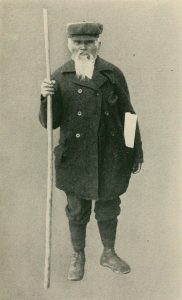While the response of Canadian authorities to Covid-19 has not been ideal, it at least makes a better-than-average grade, and the initial sluggish response is quickly giving way to a science-based one. Testing levels are still woefully inadequate. I have to admit that even Ontario’s notoriously slimy Conservative administration is showing competence, and Premier Doug Ford, a congenital fathead, has been on his best behaviour. The Prime Minister is in isolation because of his wife’s positive test, and gives press conferences alone. Ninety percent of government business is now being conducted by skype or other virtual platforms. Here in Ontario, public gatherings are suspended, restaurants are closed except for take-out, and delivery carriers wear face-masks. Only supermarkets and pharmacies remain open. The border is now closed with the United States, with various economic and medical-based exceptions. There was considerable “panic buying” over the weekend, and you can’t find either eggs or toilet paper for the moment, but even at the height of this panic buying people remained polite and well-behaved. Supermarkets are assuring that they will be restocked quickly, and prices will remain the same. As of this writing, eight Canadians have died. The superiority of a single-payer public health insurance system in such an emergency is self-evident beyond the slightest doubt.
In the U.S., various state governments have been taking up the slack of a pathetically inept and corrupt White House, and America must place it’s hopes in local infrastructures. Notable is Washington State, which has been hard hit and requires drastic measures. Washington has about twice as many cases as all of Canada and has had 52 fatalities. Washington’s Public Health authorities are facing a fierce foe. But to demonstrate that state’s creative spirit, the best online website for consolidating current world Covid-19 statistics was built as early as last December — by Avi Schiffman, a seventeen-year-old high school student in a Seattle suburb.
American State-level authorities have been responding admirably, but to show you the difference between the two Federal administrations, I submit the following image from a White House press conference taken a few hours ago:
 The most basic protocols in an epidemic are being visibly violated by the President, Vice President and his staff. This is idiocy, incompetence and corruption in a nutshell.
The most basic protocols in an epidemic are being visibly violated by the President, Vice President and his staff. This is idiocy, incompetence and corruption in a nutshell.
By contrast, this is a press conference, for identical reasons, conducted at the same time by Finance Minister Bill Morneau and Bank of Canada Governor Stephen Poloz following the Prime Minister’s solo address:
They are maintaining the proper six-foot distance, the few journalists present are as well, and the bulk of questions are being asked through the internet. This is following protocol.
Canadians have had little experience with epidemics since the polio outbreaks of the 1950s and the global flu pandemic of 1918. The most serious recent issue was the SARS event of 2003, which killed 44 Canadians and was largely confined to Toronto. I was working in a medical laboratory at that time, handling potentially infectious materials, so I was kept abreast of the issue and had to follow very tight protocols. To this day, I keep my own home well stocked with disposable gloves, swabs, cleaning agents and large quantities of hydrogen peroxide — so I didn’t have to run out and buy any of these items. For that matter, I am also stocked with enough household supplies (such as bins of rice, dried beans and peas, flour, couscous, millet, as well as canned goods) to stay at home for months, if necessary. Toronto hospitals were caught with their pants down during SARS, and I’m told that standards are considerably better now.
But if you go back in history, you can learn what having to deal with the real horrors of epidemic disease is like. I’m presently reading an amazing book called The Many Voyages of Arthur Wellington Clah, by Peggy Brock.
Arthur Wellington Clah was a Tsimshian man born in 1831 in a village in the Nass River valley of coastal British Columbia. At the age of 26, Clah [his hereditary name was Sgała’axł Xsgiigł] was taught to speak and write English by William Duncan, an Anglican missionary, and adopted a personal version of a Christian religious faith, giving no allegiance to either the Anglican or Methodist sects that he was exposed to. During his long life, he worked at a wide variety of jobs, was often an ambitious entrepreneur, and travelled widely in B.C., Alaska, the Yukon, and Washington State.
Within months of learning to write, he began to keep a diary, and he maintained this diary for the next fifty years. Over this half century, he produced over 650,000 words of hand-written entries, the equivalent of Tolkien’s combined Hobbit, Lord of the Rings, and Silmarillion. By 1890 it had evolved into a repository of his personal philosophical musings and an ambitious attempt to write a history of his people. Clah was proud of his work and wanted to see it published for posterity, but the manuscript languished for a century in the stacks of the Wellcome Library in London. It presents many difficulties to researchers because Clah’s English was very crude in the beginning, and was never the language he thought in. It contains little punctuation, and because of its idiomatic specificity can only be puzzled out by someone very familiar with the complexities of the Tsimshian, Nisga’a, Haida, Heiltsuk, Kwakwaka’wakw, and Tlingit cultures of the region. Peggy Brock’s book draws on the diary and explains its context in order to produce a balanced biography of Clah. This is admirable and quite difficult scholarly work, so I will not diminish it with any kibitzing.
When Clah began this diary, there were but a handful of Europeans in British Columbia, and the aboriginal population counted hundreds of thousands. The Tsimshian and other coastal people lived in substantial towns of large wooden buildings decorated with art that still dazzles and amazes the world to this day. By the end of it, the European and Asian populations far outnumbered them, and most of the 20 or so aboriginal nations, who spoke disparate languages and pursued widely varying lifestyles, had been massively disrupted and diminished by the effects of dealing with gold-rushes, incoming settlers, the imposition of Colonial and then Canadian government, religious conversions, the rise of forestry and fish canning, urbanism, the suppression of the Potlatch, and most of all, infectious disease. When he made his last entries as a somewhat lonely and embittered man with failing eyesight, he described the streets of his native village:
I walk up Gitlaxdansk village. The place half empty, use[d] to be big place. [F]irst time I take my wife in that tribe [,] good many people [:] strong tribe and rich people to all tribes on [N]ass river [.] [N]ow tribe very poor. [P]eople very near all out. [G]o easy places the young people.
While the various cultural and political shocks that aboriginal societies in the Pacific Northwest (on both sides of the Canadian/American border) experienced were serious, nothing was as overwhelmingly destructive as infectious disease, particularly smallpox. This began appearing as early as the 1790’s either introduced by the Spanish ships that explored the coast, or more likely travelling up through the Basin & Range regions from the Spanish settlements in New Mexico, carried by the complex trade networks of the Mandan. But the real devastation began in the 1820s, as American settlers along the Oregon Trail brought smallpox and measles. From then on, the death rate often exceeded 80% of the aboriginal population in a single season, and wave after wave of such pandemic slaughter drifted northward into Clah’s homeland. Clah’s village experienced a disastrous smallpox epidemic when he was five years old.
Brock writes:Clah remembered the smallpox epidemic of 1836 and the many who died from the disease. His account of the epidemic of 1862 is much more detailed. In that year, smallpox, which had been introduced to Victoria via a ship from San Francisco, quickly spread through the Tsimshian Reserve at Rocky Bay and then to other camps. Tsimshian expelled from Victoria took the disease north. Frightened people were given a day’s warning to vacate the reserve. They burned their houses and blankets before leaving, and a gunboat in the bay ensured their departure. Although doctors started vaccinating people in Victoria, three hundred Tsimshian had contracted smallpox and twenty had died by late April. Doctors also went up the Coast to vaccinate the Aboriginal population, as did Duncan, who was concerned the vaccinations were not taking. It is impossible from the data available to determine their effectiveness. The epidemic ran its course by December, when Clah wrote to Duncan that there had been 301 deaths and 2,069 survivors among the Fort Simpson tribes. Presumably, Clah had been vaccinated, for he did not get the disease, even though he nursed relatives with smallpox. The Tsimshian also tried treating themselves with remedies such as “woomash” plant, which Clah went up the Nass River to collect in July.
This catastrophe ruptured the spiritual cosmos and social fabric of Tsimshian society. Drinking and violence were two symptoms; burning religious paraphernalia and making sacrifices for absolution were others. Clah believed the Tsimshian had angered the Christian God by lying, stealing, committing murder, and engaging in drunken fighting. He prayed for God to forgive them and take away the sickness. This crisis no doubt pushed others towards Christianity. Duncan’s mission certainly benefited.
Epidemic disease was one of the chief moulders of Clah’s life and worldview. Of his dozen children only three survived to adulthood. Two sons lived only to the ages of twelve and thirteen, both killed by measles. Two daughters died in their mid-teens. His last son made it to the age of 23. Far from any fatalistic Stoicism, the diaries are filled with accounts of the emotional trauma caused by these deaths. But Clah’s resolute devotion to telling his story is best shown in an entry made as his sight began to fail: “My eyes half blind. I see day like smoke. But I don’t stop writing.”

